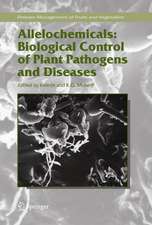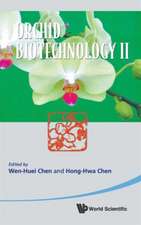Chemical Ecology of Plants: Allelopathy in Aquatic and Terrestrial Ecosystems
Editat de Inderjit, Azim U. Malliken Limba Engleză Hardback – 21 noi 2002
| Toate formatele și edițiile | Preț | Express |
|---|---|---|
| Paperback (1) | 701.68 lei 6-8 săpt. | |
| Birkhäuser Basel – 5 noi 2012 | 701.68 lei 6-8 săpt. | |
| Hardback (1) | 646.30 lei 6-8 săpt. | |
| Birkhäuser Basel – 21 noi 2002 | 646.30 lei 6-8 săpt. |
Preț: 646.30 lei
Preț vechi: 760.35 lei
-15% Nou
Puncte Express: 969
Preț estimativ în valută:
123.67€ • 129.12$ • 102.35£
123.67€ • 129.12$ • 102.35£
Carte tipărită la comandă
Livrare economică 04-18 aprilie
Preluare comenzi: 021 569.72.76
Specificații
ISBN-13: 9783764365356
ISBN-10: 3764365358
Pagini: 288
Ilustrații: X, 272 p.
Dimensiuni: 178 x 254 x 21 mm
Greutate: 0.58 kg
Ediția:2002
Editura: Birkhäuser Basel
Colecția Birkhäuser
Locul publicării:Basel, Switzerland
ISBN-10: 3764365358
Pagini: 288
Ilustrații: X, 272 p.
Dimensiuni: 178 x 254 x 21 mm
Greutate: 0.58 kg
Ediția:2002
Editura: Birkhäuser Basel
Colecția Birkhäuser
Locul publicării:Basel, Switzerland
Public țintă
ResearchCuprins
Problems and prospects in the study of plant allelochemicals: a brief introduction.- Antifungal properties of cyanobacteria and algae: ecological and agricultural implications.- The chemistry and chemical ecology of biologically active cyanobacterial metabolites.- Compounds from Typha domingensis P..- Allelochemicals from sunflowers: chemistry, bioactivity and applications.- Feedback mechanism in the chemical ecology of plants: role of soil microorganisms.- Do allelochemicals operate independent of substratum factors?.- Ecological relevance of allelopathy: some considerations related to Mediterranean, subtropical, temperate, and boreal forest shrubs.- Linking ecosystem disturbance with changes in keystone species, humus properties and soil chemical ecology: implications for conifer regeneration with ericaceous understory.- Black walnut allelopathy: current state of the science.- Allelopathy and agroecology.- Allelochemicals phytotoxicity in explaining weed invasiveness and their function as herbicide analogues.- Shift in allelochemical functioning with selected abiotic stress factors.- Pitfalls in interpretation of allelochemical data in ecological studies: implications for plant-herbivore and allelopathic research.- Biochemical and physiological aspects of pollen allelopathy.
Textul de pe ultima copertă
Allelochemicals play a great role in managed and natural ecosystems. Apart from plant growth, allelochemicals also may influence nutrient dynamics, mycorrhizae, soil chemical characteristics, and microbial ecology. Synergistic action of various factors may better explain plant growth and distribution in natural systems. The book emphasizes the role of allelochemicals in shaping the structure of plant communities in a broader ecological perspective. Readers will gain a unique perspective on plant allelochemicals research by a multifaceted approach to understand the role of these compounds.
The book addresses the following questions: (1) How do allelochemicals influence different components of the ecosystem in terms of shaping community structure? (2) Why is it difficult to demonstrate interference by allelochemicals (i.e., allelopathy) in a natural system in its entirety? Despite a large amount of existing literature on allelopathy, why are ecologists still skeptical about the existence of allelopathy in nature? (3) Why are there only scarce data on aquatic ecosystems? (4) What role do allelochemicals play in microbial ecology? How does altered soil microbial ecology influence community structure and fate of allelochemicals? (5) What role do allelochemicals play in nutrient dynamics in terms of final influence on plant growth and distribution? (6) How do abiotic and biotic factors of an ecosystem influence the functioning of allelochemicals? (7) What are the main pitfalls in presentation, analysis, and interpretation of allelochemical data?
There is a growing appreciation that population- and ecosystem-based approaches complement each other strongly, and in view of this the concept of allelopathy is now applied effectively to address ecosystem-level questions. The objective of this volume is to discuss the questions above to find out the effect of allelochemicals on structure and function of the ecosystem. Readers will gain a unique perspective onplant allelochemical research through a multifaceted approach to understanding the role of these compounds.
The book addresses the following questions: (1) How do allelochemicals influence different components of the ecosystem in terms of shaping community structure? (2) Why is it difficult to demonstrate interference by allelochemicals (i.e., allelopathy) in a natural system in its entirety? Despite a large amount of existing literature on allelopathy, why are ecologists still skeptical about the existence of allelopathy in nature? (3) Why are there only scarce data on aquatic ecosystems? (4) What role do allelochemicals play in microbial ecology? How does altered soil microbial ecology influence community structure and fate of allelochemicals? (5) What role do allelochemicals play in nutrient dynamics in terms of final influence on plant growth and distribution? (6) How do abiotic and biotic factors of an ecosystem influence the functioning of allelochemicals? (7) What are the main pitfalls in presentation, analysis, and interpretation of allelochemical data?
There is a growing appreciation that population- and ecosystem-based approaches complement each other strongly, and in view of this the concept of allelopathy is now applied effectively to address ecosystem-level questions. The objective of this volume is to discuss the questions above to find out the effect of allelochemicals on structure and function of the ecosystem. Readers will gain a unique perspective onplant allelochemical research through a multifaceted approach to understanding the role of these compounds.















